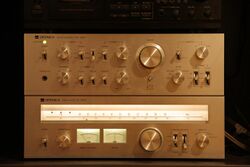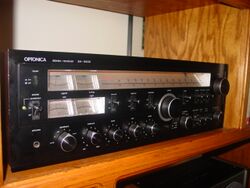Company:Optonica
Optonica was a subdivision of Japan ese electronics manufacturer Sharp that made high end hi-fi products systems.
History
1976
The Optonica brand was created and first launched by Sharp in 1976 to compete in the high-end audio market along with established brands such as Sansui Electric, Sony, Panasonic, Sanyo, Yamaha, Nakamichi, Onkyo, Fisher Electronics, Technics (brand), Pioneer Corporation, Kenwood Corporation, JVC, Harman Kardon and Marantz.
The first series of receivers, the SA-4141 and SA-5151, were beautifully designed and well built with silver front faces and attractive knobs and switches. The 4141 had 65 watts per channel in the 4141, and the 5151 had 85 watts per channel. The early line included a modest selection of AM-FM tuners and amplifiers that were of the same high quality, offering beautiful styling and superb performance. Cassette players and recorders were offered, most with the popular silver faceplates, but a small line known as the "designer series" offered a black faceplate in model number ST-1515B and SM-1515B for both tuner and amplifier respectively.[1]
Probably the most notable product during the first run was their direct drive turntable RP-3636 that is sought after by collectors and audiophiles today due to the unique construction of Mikage Granite Stone that was developed by Optonica for use in turntable design.[2] It was a compound that virtually eliminated feedback, thus preventing resonance from reaching the tonearm. The turntable was very heavy, weighing in at 35.4 pounds.
1979 - 1980
The second series was offered in 1979 and the line was expanded and redesigned with products that covered the entire spectrum of the high end market. The top of the line consisted of model numbers SA-5901 and SA-5905, both priced at 800 dollars retail, with an amazing 125 watts per channel at minimal distortion levels (.02%), and a line of lower output receivers with both black and silver metal faceplates for each model. [3] One of the unique features of these receivers was the ability to turn off the radio section of the receiver with the press of a switch. The massive receiver then became an amplifier, without the power drain on the radio section. The receivers throughout the line were styled with similarities to each other and build quality was high and consistent from the most expensive to the lowest.
During this period, Sharp introduced unique design features into the products, most notably the dual arm system turntable RP-7705, famous for an APLD (auto program locate device) that enabled the operator to select a cut on the album and the tone arm would automatically be placed on the desired song.[4] This turntable had a sensor arm that was built next to the tonearm.
During this period Optonica still offered analog AM-FM tuners and amplifiers, but new digital tuners and amps were now offered with a Toroidal power transformer that allowed for high performance in a smaller size, offering two to three times the capacity of conventional transformers. This allowed for the new digital tuners and receivers to be much smaller in size, compared with the conventional line of products.
The cassette recorder line was increased with unique computer-controlled devices, among them model number RT-6905.[5] This cassette deck employed every high level performance standard, and had memory functions along with remote control and calendar functions that employed memory to record on specific times and dates.
Other notable computer-controlled Optonica cassette decks were the RT-6506, RT-6501 and RT-6505, famous for their microcomputer application.[6]
Optonica offered many accessories to the 1979 line, including custom fitted cabinets for components and a plethora of rack handles designed to custom fit many of the products in the line.
All products came with a two-year parts and labor guarantee, and the speakers were given a five-year guarantee.
1981-present
A third series of digital equipment appeared, added to those that appeared in 1979, and seemed to be marketed as a complete system, versus the separate component marketing approach that dominated during the earlier years. They were styled and highly modernistic in design, with the 9100 series as the top of the line.[7] It was offered in silver and brown, and offered the APLD turntable but added a remote control feature to the unit. This table was model RP-9100 H/HB. A tape processor (RT-9100 H/HB) was offered, similar to the unit introduced in 1979.[8] The stereo amp put out 130 watts per channel at 4 ohms with .005% distortion, so they were very powerful. Optonica offered two other series and increased the number of speaker offerings to go along with the three separate series of audio packages. Accessories were available such as custom fitted display cases to hold the equipment.
A last series of limited equipment was offered, most notably RP-114VL BLST, a linear tracking upright turntable, that could play both sides of a record without having to change sides. Total command of track selection was now possible and could be programmed in any order as desired.
The complete package concept would end and digital receivers would return but with lower power ratings, and matching cassette recorders were far smaller than the previous models, offering less complexities and timing devices, but quality was starting to slip, as compared to the build and bulk of the previous earlier models. Eventually the Optonica brand was eliminated but would emerge once again in the late 1980s as a line of high-end stereo television receivers, VCR, CD, portable cassette and CD radios, voice-activated remote controls, and surround sound receivers for television and audio listening. These products were available until the early 1990s, and that marked the end of the Optonica high-end line of audio and video products.
The Optonica line would be relegated to history but, with the introduction of the internet and eBay, would experience a renaissance of interest by collectors or audio enthusiasts who are looking for a good value in high-end audio products.
Products
Optonica's products were mainly hi-fi components such as single and dual cassette decks, turntables, speakers, receivers and amplifiers. Later Optonica products released from 1988 to 1991 included 20", 27", 32" CRT TVs, and VHS / S-VHS VCRs.
External links
- Sharp Corporation Global website
- Optonica RT-3838 cassette deck and history
- List of Optonica vintage cassette decks
References
- ↑ Optonica sales catalogue OP-FB 10/77, pg. 5, 7, 24
- ↑ Optonica sales catalogue OP-FB 10/77, pg. 26, 27
- ↑ Optonica sales catalogue OP-FB 8/79, pg. 8, 9
- ↑ Optonica sales catalogue OP-FB 8/79, pg. 48, 49
- ↑ Optonica sales catalogue OP-FB 8/79, pg. 30, 31
- ↑ Optonica sales catalogue OP-FB 8/79, pg. 32-35
- ↑ "Optonica The Art Of Silence" 1981-82, pg. 5
- ↑ "Optonica The Art Of Silence" 1981-82, pg. 12



